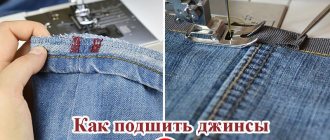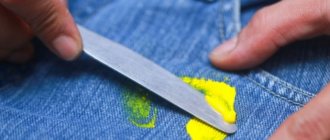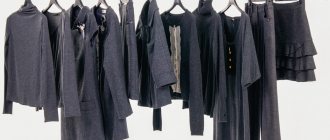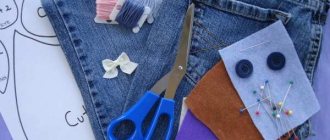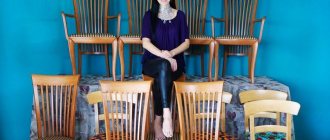How narrow can you make your jeans?
How to properly sew jeans and how much you can narrow them. In fact, there are quite a few ways, and how much fabric will need to be removed depends on the owner of the item. The future shape of jeans is obtained taking into account the height and physique of a person. Jeans can be hemmed either “by eye” or using a constructed pattern. Also, the shape will depend on preferences and the desired length of the item.
Skinny jeans
To sew in jeans, you can take other pants as a basis, which will become an example of the required length and shape. To work with them, you just need to attach the products to each other and circle the place where the seam will be in the future.
Outlining old pants
To reduce the size of an item (without using a pattern), you will definitely need pins or small clothespins. After basting the seam, they are removed.
Note! The new look of the pants is a choice based on personal preference. However, it is worth considering that before sewing you need to try on jeans. The pant leg should fit easily on the leg.
How to sew in the sides of pants
How to sew in the sides of trousers so that they fit your figure, you will agree that sagging fabric in the hip area spoils the appearance, so proceed as follows:
- Put your jeans on inside out, mark with pins how many centimeters you want to remove on the sides;
- Draw narrowing lines with chalk;
- Rip the waistband over the side seams;
- Open the side seams themselves;
- Baste the product along the lines marked in the preliminary fitting;
- Try on the item, evaluate its appearance;
- If you are satisfied with the result, then start sewing;
- Sew overcast seams on a machine;
- Reduce the waistband by cutting off excess fabric and sew it to the jeans.
You can’t keep up with fashion, jeans styles change every year from flared, to skinny, from long to short with turn-ups, so don’t be afraid to experiment and take matters into your own hands. Create masterpieces with your own hands, and we will help you with this.
Model preparation
Before you start sewing jeans, you need to prepare the model for work. Pants can be hemmed not only from the bottom, but also in other places where it is necessary. If the goal is to narrow the item at the bottom, then the product is turned inside out and the bottom seams are ripped out, which are then ironed well.
It is worth noting that both women's and men's pants are sewn according to the same principle. The final result will depend only on the preferences of the person himself.
Note! The following life hack may help - before sewing in jeans at the waist, they should be washed at least once. This will prevent things from “settling” in the future.
Ironing things
Preparation for sewing at the hips consists of cutting the side seams (which are located higher), and to reduce the waist, the item is unzipped from the back. When ironing, special attention should be paid to the seams, so that later it will be easier to work with them. When cutting, it is important to be careful not to cut off too much or make a crooked line.
The following tips may be helpful when sewing:
- During work, you should try on the item several times to make sure there are no inaccuracies.
- If you have trousers in your wardrobe that match the required style, you can use them as a template.
- Don't rip your pants completely. Seams in the crotch area are quite problematic to sew on your own, especially for beginners.
- It’s worth specially purchasing strong threads if you don’t have them. Thin ones can tear at any moment, and all the work will be ruined.
- It is recommended to process the cut edges with an overlock or zigzag stitch, as denim tends to fray, and this will cause the item to suffer when worn.
You might be interested in this Janome Sewing Machine Manual
Suturing in the waist area
To reduce the size of the product in the belt, three options are offered.
With the help of darts
The method is labor-intensive, but effective; it will help to sew in jeans by 5-7 cm.
- Open the waistband between the back side seams.
- Turn the product inside out and put it on.
- Pin the back darts along the figure at the same distance from the middle seam.
- Take off your pants, draw a line and mark them according to the marks.
- Iron.
- Choose the appropriate thread color.
- Sew using a machine.
- Undo the middle belt loop.
- Cut off excess fabric from the waistband, stitch it and sew it to the jeans.
- Sew a belt loop in the middle and iron the product.
This option involves working with darts at the back, but there are other options. You can make darts on the sides. Here it is sutured on both sides - step-by-step (internal) and (lateral) external. It is sutured from the side when it is necessary to remove excess only in the femoral area.
Suturing at the seams
It is allowed to sew both one back seam and two side seams.
Working with side seams:
- Open the belt to the right and left, no more than three centimeters to the right and left of the seam.
- Open the seams themselves from both sides to the thigh.
- Select the protruding threads.
- Turn the pants inside out and put them on.
- Reduce the required amount of fabric and secure the selected position with pins.
- Draw a straight line and baste along it.
- Iron.
- Attach the second leg to the processed one and transfer the measurements.
- Try it on again. If everything is satisfactory, trim off the excess material.
- Finish the edges of the cut.
- Machine stitch the seam.
- Steam the product.
If you need to remove an extra couple of centimeters, you can simply sew along the middle seam at the back. The procedure is practically no different from the previous one, only the stripping of the belt is carried out in a different place. You will also have to remove the belt loop for a while. Only one seam is unraveled, which simplifies the procedure.
Using an elastic band
Reducing by inserting an elastic band will help if the product is no more than 3 cm large.
You should proceed step by step:
- Measure your waist circumference with a measuring tape.
- Cut the elastic 5-7 cm shorter than the resulting number, because after stretching the desired size will come out.
- Make 2 cuts in the waistband of the trousers from the inside out.
- Place a safety pin through the elastic.
- Pull it into the belt and sew it to it.
- Try on the item - it's ready.
If you choose the right elastic band, your jeans will fit perfectly. Here you can do without a sewing machine if you don’t have one.
Important! Buy a thick and wide elastic band; a thin and weak one will not hold such a hard and heavy material.
Required Tools
How to make jeans narrower, and what tools are needed for this? For high-quality work you will need a fairly large amount of materials. Denim fabric is dense, as are the seams, so you need to work with it carefully. Some tools are selected just for this density. In order to make jeans narrower, you will need:
Required Tools
- Electric sewing machine.
- If possible, use an overlocker for stitching. If it is not there, use the zigzag mode on the machine.
- Scissors. For thick fabrics, tailor's ones are best.
- Chalk or bar of soap.
- Threads and needles for sewing.
- Long ruler or centimeter.
- Iron.
If you don’t have tailor’s scissors, you can take regular ones, but working with them will be a little more difficult, especially when cutting seams.
Features of processing the bottom of the product after narrowing the legs
After tapering, it is necessary to work clearly and carefully with the trouser legs. You must try to connect the old and new seams smoothly so that the transition is imperceptible. The entire lower part should be well ironed, all seams smoothed. To do this, you can use a special sleeve block or a hand-made pad.
Important Details
When using an overlocker, it is necessary to process the allowances on the front half of the trousers. The selection of threads must be carried out taking into account the color of the fabric. The stitch width on the machine for processing the lower part should be no more than 0.4 cm. In order to make a denser finishing stitch, you can use a double thread.
Work algorithm
The work steps may vary depending on where you need to remove excess fabric. Typically tapering is required at the waist or bottom. How best to sew wide jeans at the waist - by hand or by machine - is not so important. The main thing is to follow the step-by-step instructions, which are suitable for both denim breeches and shorts. The easiest way:
- Several darts are marked in the waistband area, which are then carefully torn off.
- Next, the darts are stitched (by hand or with a machine).
- The remaining material is cut off and the belt is sewn back.
Narrowing at the waist
It is worth remembering that if you have any doubts about working with clothes yourself, you can always contact a tailor. There, wide trousers will lead to the desired style quickly and efficiently. In some cases this is indeed the right decision. For example, this applies to very expensive things that you don’t want to ruin when sewing. Prices in the studio vary depending on the city and prestige. Typically, the service of sewing up trousers costs the client 400-600 rubles.* It all also depends on where the excess fabric needs to be removed. You can contact the studio if you don’t have an overlocker or machine at home - processing will cost 50 rubles/m.
Along the side seams
Stitching along the side seams is used when the trouser legs are wide at the very bottom, at the calves and slightly above. Typically, flared trousers that do not like the shape, and trousers that do not fit, are processed.
You might be interested in this Instructions for sewing a knitted cardigan yourself
How to sew jeans in the legs - the following algorithm will tell you:
- First, you need to try on the jeans to understand where to sew them in and how much. Selected places are secured with pins.
- It’s worth checking again before altering how the item fits your figure.
- Place the jeans on a hard, flat surface and straighten them well so that there are no creases left anywhere.
- Using a bar of soap, draw a line for the future seam at the place where the pins are attached.
- Threads are used to sweep away excess fabric onto items.
Sewing flared trousers
- The pants are tried on again to check for any flaws. It is worth noting that if the jeans are long, they are first shortened to the desired size (but not stitched), and only then the excess is removed from the sides.
- Excess fabric is cut off, leaving an allowance of 1-2.5 cm.
- Then the edges are processed using an overlock or zigzag stitch. The thread is selected according to the shade of the jeans. Edge processing is necessary because... cut fabric quickly deteriorates and crumbles.
- After processing, they begin to sew new seams, carefully connecting them with the old ones.
- The product is ironed and tried on.
If there are no flaws, excess threads are removed.
Tapering the pants at the sides
Topstitching
Stitching is done to give new jeans a finished look. It is needed so that the inner seam does not look too clumsy.
Topstitching
- You need to take threads that match the color of the existing stitching.
- An approximate seam is applied, simulating a factory one.
- The thing is ironed. At this stage, the bottom of the trouser legs is folded and stitched.
To make the stitching look neat, it is recommended to take thick threads or connect 2 thin ones. It is allowed to use black threads in the place of the shuttle.
Sewing a new stitch
Useful tips
Tapering jeans yourself at home is not as difficult as it seems at first glance. By strictly following the recommendations, you can avoid going to the studio. Here's what experts advise:
- When sewing the bottom of the trouser leg at the intersection with the transverse seam, you need to lift the foot and place an additional piece of material (cardboard, plastic card) under the back of it. This will help to avoid sudden changes in fabric thickness and gaps in the stitching.
- The threads that will be used to process the edges must match the color of the material.
- If you don’t have an overlocker, you can overcast the cutting part by hand. Even minimal processing of the edges will make the seam independent and protect the product from “spraying” and breaking through.
- The thread that is visible on the outside of the jeans should be the same color as the other seams.
- The finishing stitch can be done with double thread. To do this, two coils of the same color are inserted into the machine. One thread is used in the shuttle, and it is better if it matches the finishing stitch.
You can learn more about how to narrow jeans by watching a video master class from a specialist
Method using old trousers
How to sew wide leg jeans using old pants? The technique is not much different from stitching along the seams and waistband. In this case, the “ruler” will be old homemade jeans that match the shape of the legs and length. However, when using this method, you need to take into account some operating conditions.
- You need to work with two products on a flat surface, preferably wide enough to place jeans on it.
- The old product must be fixed. If the jeans constantly “slide” from each other, drawing future seams and making basting will be quite problematic. Jeans that have been altered may turn out uneven.
- When working, it is important to take into account the existing defects in the sample; they can complicate the work a little. For example, if the pants are stretched at the knees or there are slits, you need to straighten the product well.
- After taking measurements and basting the fabric, it’s still worth trying on new jeans, even if the sample fits your figure perfectly.
You might be interested in this Description of all types of seams for hand and machine sewing
Using old jeans as a pattern is a fairly simple method, suitable for those who do not want to create a pattern. This method is quite universal - it can be applied not only to jeans, but also to other types of trousers.
Sewing pants using an old pattern
Suturing in the thigh area
If the pants are wide at the top of the legs, it is advisable to sew along the side seam.
- Put on your pants with the inside out.
- Mark with pins how much fabric needs to be removed.
- Remove the product, draw lines under the ruler with a pencil (chalk or soap).
- Open the belt and pockets.
- Open the side seams.
- Baste new ones along the lines.
- Using a machine, stitch along the marks from the inside and make 2 lines from the face.
- Be sure to overlock the edges and iron the product.
If the measurements are taken correctly, the pants will fit correctly.
Method using a pattern
Pattern making is a complex method of narrowing an item, requiring certain knowledge and skills. However, only thanks to him a high-quality and accurate result is obtained. In addition, the constructed template can help in the future if you need to alter several more pairs of pants. To make a pattern for future trousers, you can use the following method:
- For construction, you can use a piece of wallpaper. Those jeans that have a suitable shape are ripped and smoothed out the resulting parts.
- One part is placed on paper and the outline is drawn.
- The thing that needs to be redone is also ripped out in the right places. The cut out pattern is placed on it and outlined with a bar of soap or chalk. It is important to remember to leave an allowance for stitching.
- The pants are sewn on a sewing machine, according to the pattern.
- Then the product is turned back to the front side and stitching is performed.
At the very end, the bottom is also processed, as in the method without a pattern.
Creating a pattern for denim trousers
Without using a machine
How to make jeans skinny without using technology? You can do this yourself, without even using needles and threads.
- You need to put on jeans and stand in front of the mirror.
- The desired width of one trouser leg is fixed by hand.
- The excess should be folded onto the left side.
- The folded fabric is held at the edge, and then the trouser leg is wrapped as many times as necessary until the desired width is obtained.
- If you are satisfied with the result, do the same with the other part of the jeans.
This method is good because it does not require any additional tools. In addition, it is considered “reusable” - with it you can try different lengths and widths on the same jeans, creating a new look each time. This method may seem complicated at first, but if you do everything slowly, following the instructions, everything will work out in the end.
Trying on before tapering
Thanks to such a variety of methods, the question “how to make jeans narrower?” no longer arises. From all the methods listed above, you can choose the one you like. But do not forget that you can always contact a studio if you are not confident in your skills.
*Prices are current as of August 2022.

